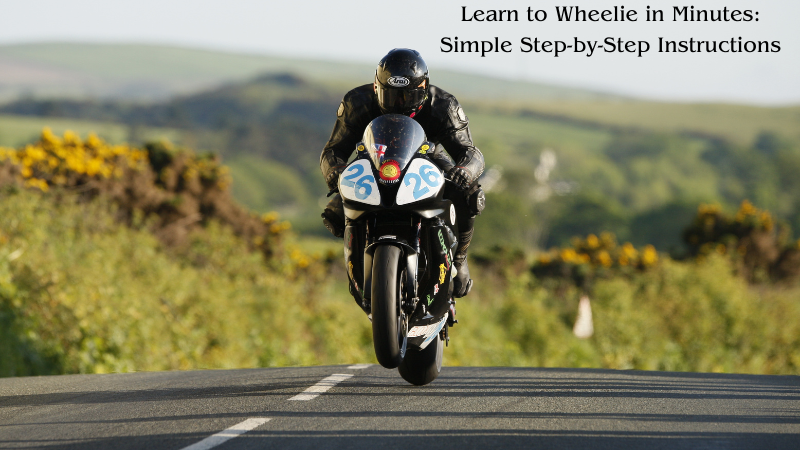If you’ve ever wanted to pop a wheelie and impress your friends (or just yourself), you’re in the right place. Let’s take a look at the basics of performing a wheelie safely and effectively.
What Makes a Motorcycle Wheelie?
A wheelie isn’t magic—it’s physics! To do a wheelie, you need to control the throttle, clutch, brakes, and your body position. This helps create torque and angular momentum. When done right, these forces lift the front wheel off the ground. This helps you keep your balance for as long as you can.

The Science Behind a Wheelie
- Torque is the rotational force from your engine. It goes to the rear wheel and lifts the front wheel off the ground.
- Angular Momentum: The force that keeps your motorcycle stable while the front wheel is in the air.
- Throttle and clutch control help you manage power and keep balance when doing a wheelie.
Experienced riders can control these forces better than beginners. They also manage the natural fear of falling.
Are Wheelies Easy to Learn?
Learning to wheelie can be tough. However, with patience and practice, anyone can get the hang of it. To stay safe, always wear protective gear. Practice in an open, controlled space, away from traffic and other riders.
Once you get the hang of it, wheelies can become a thrilling skill that adds to your riding experience.
Step-by-Step Guide to Wheelie a Motorcycle
Step 1: Start in First Gear
Starting in first gear makes it easier to lift the front wheel. The lower gear gives you more torque. This helps you pop a wheelie without going too fast.
Step 2: Reach the Right Speed
- Aim for 10-15 mph for the best control.
- Too slow, and you won’t have enough power.
- Too fast, and you might lose control.
Step 3: Accelerate to Lift the Front Wheel
- Quickly roll off the throttle, then snap it back on to increase power.
- Lean back slightly and pull up on the handlebars.
- If you feel like you’re tipping back too far, tap the rear brake to bring the front wheel down.
Step 4: Maintain Your Balance
- Find your balance point by adjusting your throttle and body position.
- Keep your knees slightly bent and grip the bike tightly with your legs.
- Avoid overcorrecting, as sudden movements can cause you to lose control.
Step 5: Bring the Front Wheel Down
- Tap the rear brake gently to ease the front wheel down.
- Avoid slamming the front wheel onto the ground to prevent damage.
- Once you’re back on two wheels, maintain your speed and try again.
Does Doing Wheelies Damage Your Motorcycle?
Yes, wheelies can put extra strain on your motorcycle. The repeated impact and high torque can wear out or damage components such as:
- Engine & Clutch – Excessive stress can lead to overheating and premature wear.
- Chain & Sprockets – Increased stress can shorten their lifespan.
- Front Fork Seals – Hard landings can blow out your front fork seals.
- Tires & Rims – Abrupt landings can cause misalignment or flat spots on your rims.
If you enjoy wheelies, try practicing on a lightweight bike first. This way, you can build your skills before using your main bike.
Best Motorcycles for Learning Wheelies
Some motorcycles make learning wheelies easier than others. Here are some of the best beginner-friendly options:
1. KTM 250 XC
- Lightweight frame and powerful engine.
- Excellent power-to-weight ratio.
- Great for off-road wheelies.
2. Kawasaki KX100
- Budget-friendly beginner option.
- Lightweight and easy to handle.
- Strong resale value.
3. Honda CRF150F
- A great starter bike for small riders.
- Reliable and easy to maintain.
- Five-speed transmission with an electric start.
4. Honda Grom
- Compact and fun for city riding.
- Small 125cc engine, but surprisingly easy to wheelie.
- Lightweight and highly maneuverable.
What to Avoid When Practicing Wheelies
- Over-throttling: Too much gas can flip your bike backward.
- Hard landings: Slamming your front wheel down can damage your suspension.
- Ignoring safety gear: Always wear a helmet, gloves, and protective clothing.
- Practicing in traffic: Always find an open, safe space away from other vehicles.
- Skipping the rear brake: Your rear brake is your safety net to prevent looping out.
FAQs
Q: Can any motorcycle do a wheelie?
A: Yes, but some are easier to wheelie than others. Lightweight bikes with good power-to-weight ratios work best.
Q: Is doing a wheelie illegal?
A: In many places, yes. Check local laws before attempting wheelies on public roads.
Q: How long does it take to learn a wheelie?
A: It depends on your experience and dedication. Some riders learn in a few days, while others take weeks or months.
Q: What gear is best for wheelies?
A: First gear is ideal for beginners as it provides the most torque and control.
Q: Will wheelies ruin my motorcycle?
A: Repeated wheelies can cause wear and tear on your bike’s clutch, engine, and suspension.
Final Thoughts
Learning how to wheelie is an exciting skill that can add a fun challenge to your riding experience. With the right approach and safety measures, plus some practice, you’ll be popping wheelies soon!
Remember: Start slow, wear your gear, and always be mindful of your surroundings.
Happy riding!
